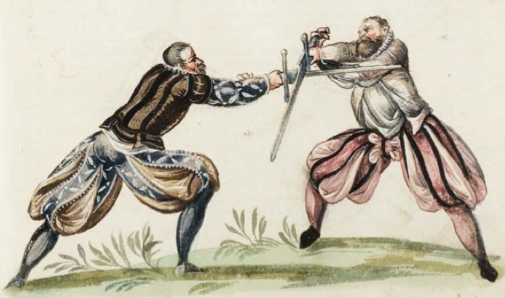Krumphauw
(→Application 1: Krumphauw to the Arms/Head) |
(→Application 2: Krumphauw as a Parry) |
||
| Line 67: | Line 67: | ||
|- | |- | ||
| [[Vom tag]], left leg forward | | [[Vom tag]], left leg forward | ||
| − | | [[Nebenhut | + | | [[Nebenhut]], left leg forward |
|- | |- | ||
| [[Passing Step]] with the right foot, [[Oberhauw]] | | [[Passing Step]] with the right foot, [[Oberhauw]] | ||
| Line 76: | Line 76: | ||
|- | |- | ||
| | | | ||
| − | | Withdraw with high | + | | Withdraw ([[Abzug]]) with a defensive high cut or a guard. |
|} | |} | ||
Revision as of 05:14, 3 July 2017
Contents |
Crooked Strike
One of the five meisterhau, krumphauw is used to defeat cuts from above, and the ochs guard.
Execution
For example; stand in a right nebenhut. When your opponent strikes an oberhau/zornhau do a passing step forward and off to the right and bring your sword over like a windscreen wiper with your hands out in front and the blade angled toward your opponent, so that you strike his blade with your long edge, or strike over to his hands.
As with the Zwerch this rudimentary "windscreen wiper" action is actually an simplification and exaggeration of the movement used. Typically the movement is much tighter and more controlled.
It is also useful to note that the krumphauw is generally more effective when the blade is angled forwards rather than cutting perpendicular to the line of movement. This allows the blow to control the opponent's blade better and shortens the distance to the follow up blow.
There is also a great deal of flexibility as to when to intercept the opponent's blade. It can fall over "behind" their blade/arms, but can also strike out the flat to deflect them perpendicular to their line of motion.
Meyer's krumphauw is a single instance of a generalisation he makes for all "crooked" cuts, which in his system includes zwerchs, shielhauws, and other strikes.
Generally if you hit the blade you should follow on the pressing the hands (hendtrucken).
Meyer describes the technique with hands held high in the cut, though this can be adjusted as required.
Application
The krumphauw can be used to parry incoming blows by deflecting or redirecting them. It can also be used to attack in a number of ways and indeed Meyer tells us that there are many secondary cuts which are simply variations on the basic crooked strike - the Sturtzhauw, for example is a high krumphauw facing out to the side.
The krumphauw can also be used from the bind; when you bind them from the right a krumphauw without taking your sword from theirs can set their sword aside, or fall down on it to bar it (Sperren).
Fencers should be wary using the krumphauw (especially in the bind) as the opponent can change through against them (Durchwechseln).
Application Example
In which the 'student' demonstrates their knowledge to the 'teacher'.
Application 1: Krumphauw to the Arms/Head
In this application the cut is being used as a Hitter in the Onset. In this case the fencer is acting in the Nach.
| Teacher | Student |
|---|---|
| Vom tag, left leg forward | Nebenhut, left leg forward |
| Passing Step with the right foot, Oberhauw | Spring to the right (and slightly away) with both fee, Krumphauw to the opponent's hands or head (whichever you can reach). |
| Withdraw (Abzug) with a defensive high cut or a guard. |
Perform this on the opposite side.
Application 2: Krumphauw as a Parry
In this application the cut is being used as a Taker in the Onset. In this case the fencer is acting in the Nach.
| Teacher | Student |
|---|---|
| Vom tag, left leg forward | Nebenhut, left leg forward |
| Passing Step with the right foot, Oberhauw | Passing Step forward right with the right foot, Krumphauw to the opponent's blade to bind it above. |
| Triangle Step to the right with the rear (left) foot, wind the blade to the left and Flick (Schneller) with the false edge Sturtzhauw. | |
| Withdraw (Abzug) with a defensive high cut or a guard. |
Perform this on the opposite side.
Related Applications
The following applications are related to, or derive from, this strike.
- Short Strike - see Kurtzhauw
- Krumphauw Breaks Ochs - see Meisterhauw

